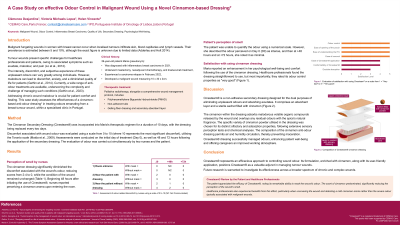Case Series/Study
(CS-037) A Case Study on Effective Odour Control in Malignant Wound Using a Novel Cinnamon-based* Dressing
Friday, May 2, 2025
7:45 PM - 8:45 PM East Coast USA Time

Victoria Michaels, PhD – CEMAG Care, Paris France; Helen Vincente, Wound Care specialist nurse – IPO, Instituto Português de Oncologia de Lisboa, Portugal
Introduction: Malignant fungating wounds in women with breast cancer occur when localised tumours infiltrate skin, blood capillaries and lymph vessels. Their prevalence is estimated between 5 and 10%, although the exact figure is unknown due to limited data1. These wounds and their associated symptoms (such as exudate, malodour, and pain) present significant challenges for health care professionals and patients, with odour having the greatest impact on patients' quality of life2, 3.
This case study evaluates a novel cinnamon odour-control* dressing in managing persistent malodour in a malignant wound.
Methods: A single-patient case study was conducted in a Portuguese wound clinic. The patient, a 39-year-old woman with inflammatory breast carcinoma, developed a malignant fungating wound after relapse following mastectomy and chemotherapy. The wound (10 x 30 x 2 cm) was treated with the following protocol: PMHD solution, non-adherent tulle, gelling fibre, and an absorbent layer. A cinnamon-based* dressing was added as a secondary dressing to manage odour. Dressings were changed every other day over a 10-day period.
Odour discomfort was assessed using the Toronto scale4 (0-10, with 10 as most severe) on initial day of treatment (D0), 48h and 72h after use. Assessment was conducted by two nurses and patient.
Results: Initially, odour was rated as "strong" by the patient and "moderate" by nurses without dressings. After 48h and 72h, odour with cinnamon-based dressing diminished to "none" for the patient and nurses.
While the wound's physical condition remained static, odour control significantly improved the patient’s psychological well-being and comfort.
Discussion: This novel cinnamon-based* dressing combines an absorbent layer with a sealed sachet containing cinnamon. Cinnamon adsorbs unpleasant volatile organic compounds and masks residual odour with the spice’s natural pleasant fragrance.
Odour management should be integral to a holistic treatment approach, incorporating patient perspectives and addressing its impact on daily life.
This case study highlights the efficacy of cinnamon-based dressing in managing malodour from malignant wounds, demonstrating its ability to improve patient outcomes and quality of life. It effectively reduced odour, enhancing the patient’s quality of life and providing a better working environment for healthcare staff. Its adaptability to wound contours contributed to patient comfort.
This case study evaluates a novel cinnamon odour-control* dressing in managing persistent malodour in a malignant wound.
Methods: A single-patient case study was conducted in a Portuguese wound clinic. The patient, a 39-year-old woman with inflammatory breast carcinoma, developed a malignant fungating wound after relapse following mastectomy and chemotherapy. The wound (10 x 30 x 2 cm) was treated with the following protocol: PMHD solution, non-adherent tulle, gelling fibre, and an absorbent layer. A cinnamon-based* dressing was added as a secondary dressing to manage odour. Dressings were changed every other day over a 10-day period.
Odour discomfort was assessed using the Toronto scale4 (0-10, with 10 as most severe) on initial day of treatment (D0), 48h and 72h after use. Assessment was conducted by two nurses and patient.
Results: Initially, odour was rated as "strong" by the patient and "moderate" by nurses without dressings. After 48h and 72h, odour with cinnamon-based dressing diminished to "none" for the patient and nurses.
While the wound's physical condition remained static, odour control significantly improved the patient’s psychological well-being and comfort.
Discussion: This novel cinnamon-based* dressing combines an absorbent layer with a sealed sachet containing cinnamon. Cinnamon adsorbs unpleasant volatile organic compounds and masks residual odour with the spice’s natural pleasant fragrance.
Odour management should be integral to a holistic treatment approach, incorporating patient perspectives and addressing its impact on daily life.
This case study highlights the efficacy of cinnamon-based dressing in managing malodour from malignant wounds, demonstrating its ability to improve patient outcomes and quality of life. It effectively reduced odour, enhancing the patient’s quality of life and providing a better working environment for healthcare staff. Its adaptability to wound contours contributed to patient comfort.

.jpg)